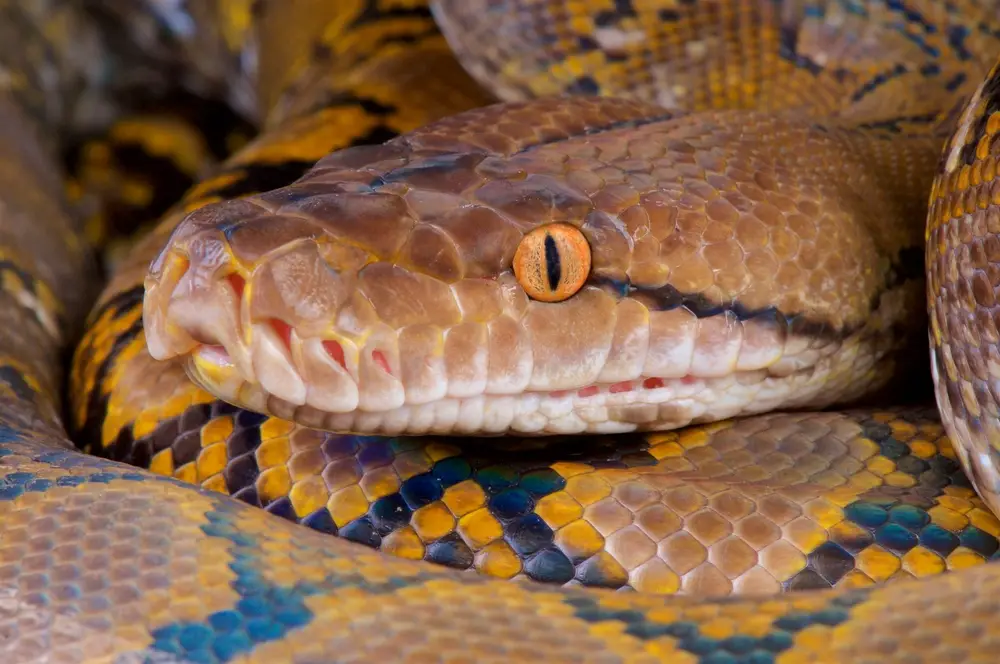Pythons live exclusively in the Old World. Most species are found in the southern hemisphere, where they have a preference for tropical climates…
The Pythonidae family is a vast collection of non-venomous constrictors that include some of the world’s largest snake species. To date, approximately 40 species of pythons have been recognized, all of which live in Africa, Asia, and Australia. They are found in rainforests, swamps, and deserts where they may be arboreal, semi-aquatic, terrestrial, or fossorial.
Recent fossil evidence suggests they may have originated from somewhere in the northern hemisphere. In fact, one 47 million year old Python fossil was found in Europe.
Notwithstanding, these days Pythons are mostlly distributed in the southern hemisphere, with their greatest diversity in Australia. Over a dozen species live in Oz, some of which are highly specialized and endemic.
Distribution of Pythons by genus
Below is a representative selection of Python species, under their currently accepted classification. If you look through the table, you’ll quickly notice that most of them are concentrated in Asia and Australasia, while the rest are in Africa.
| Genus | Latin Name | Common Name | Distribution |
|---|---|---|---|
| Python | Python molurus | Indian Python | South Asia |
| Python | Python bivittatus | Burmese Python | Southeast Asia, Florida (introduced) |
| Python | Python regius | Ball Python | West and Central Africa |
| Python | Python natalensis | Southern African Rock Python | Southern Africa |
| Python | Python sebae | Central African Rock Python | Equatorial and West Africa |
| Simalia | Simalia boeleni | Boelen’s Python | Papua New Guinea |
| Simalia | Simalia clastolepis | Moluccan Python | Indonesia |
| Simalia | Simalia nauta | Nauta’s Water Python | New Guinea |
| Morelia | Morelia spilota | Carpet Python | Australia, Indonesia, Papua New Guinea |
| Morelia | Morelia viridis | Green Tree Python | Australia, Indonesia, Papua New Guinea |
| Morelia | Morelia azurea | Northern Green Tree Python | Indonesia, Papua New Guinea |
| Antaresia | Antaresia perthensis | Pygmy Python | Australia |
| Antaresia | Antaresia maculosa | Spotted Python | Australia |
| Malayopython | Malayopython reticulatus | Reticulated Python | Southeast Asia, |
| Liasis | Liasis fuscus | Water Python | Australia, Indonesia, Papua New Guinea |
| Liasis | Liasis mackloti | Macklot’s Python | Australia, Indonesia, Papua New Guinea |
| Bothrochilus | Bothrochilus albertisii | Northern White-lipped Python | Papua New Guinea |
| Bothrochilus | Bothrochilus boa | Bismarck Ringed Python | Papua New Guinea |
| Aspidites | Aspidites melanocephalus | Black-headed Python | Australia |
| Aspidites | Aspidites ramsayi | Woma Python | Australia |
| Apodora | Apodora papuana | Papuan Olive Python | Indonesia, Papua New Guinea |

The Mexican Burrowing Python (Loxocemus bicolor)
If you’re a reptile enthusiast, you might be wondering about the little Burrowing Python, Loxocemus bicolor. This a snake that some taxonomists thought was a python for a long time. Appearance-wise, I never quite saw it myself. Also, when I handled one years ago it really didn’t feel like a real python, or act like one.
Since then, a couple of studies (Reynolds et al. 2014; Pyron et al. 2014) have found that the Mexican Burrowing Python is in fact a unique species in a family of its own: the Loxocemidae. The Loxocemidae family is now placed in the Pythonidea superfamily, meaning it is related to both Pythons and Sunbeam Snakes (Xenopeltis).
So, this species is not actually a Python, but it is related nonetheless. As you might guess, it is found in southern Mexico and Central America.
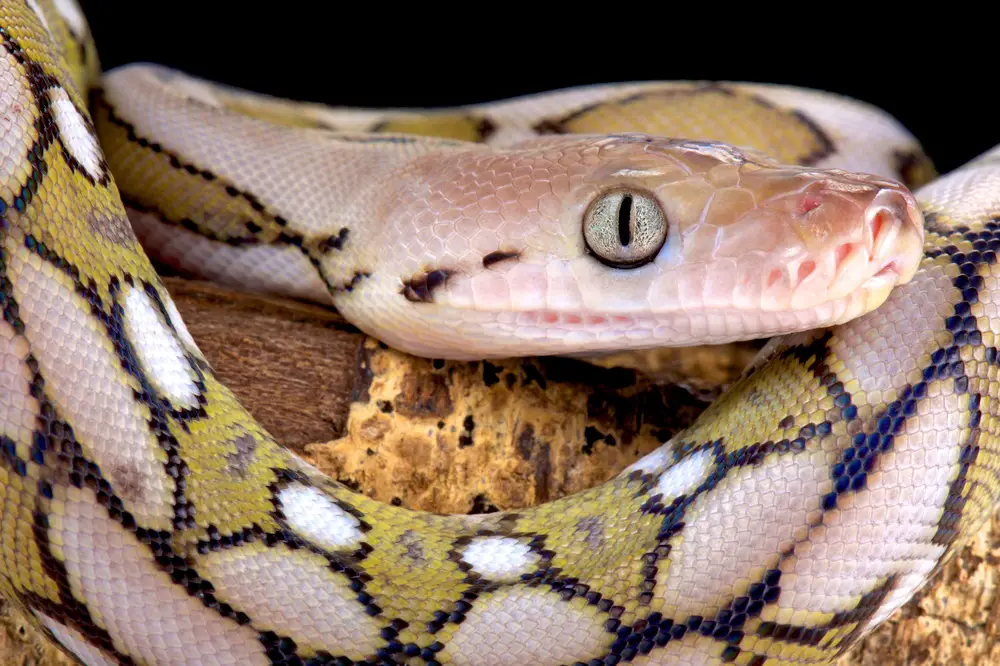
What do pythons eat?
Most Pythons are medium to large snakes that are sometimes even the apex predators in their ecosystem. Large species like the African Rock Python or the Reticulated Python regularly take down antelopes, monkeys, feral pigs, feral goats, deer, and water fowl.
Smaller Python species like Green Tree Pythons and Womas obviously focus on smaller prey, but may also eat more reptiles and birds as part of their diet.
The type and quantity of food eaten also depend on the size, age, and total body weight of the python. Typically, an adult python needs to eat a small meal every 7 to 14 days. If it gets a big meal, however, it can easily fast for a couple months afterwards.
Where do pythons live in the United States?
Gone are the days when Pythons were only found living in remote tropical forests. One species in particular, called the Burmese Python, is now living in southern Florida as an invasive species.
In the 1990s, a python breeding facility was wrecked after a hurricane struck the state of Florida. It released more than a dozen snakes, due to which today there are thousands of pythons breeding and thriving in Florida.
Fortunately, they aren’t growing to gigantic sizes and eating people. They are eating the local wildlife and damaging the ecosystem, however.
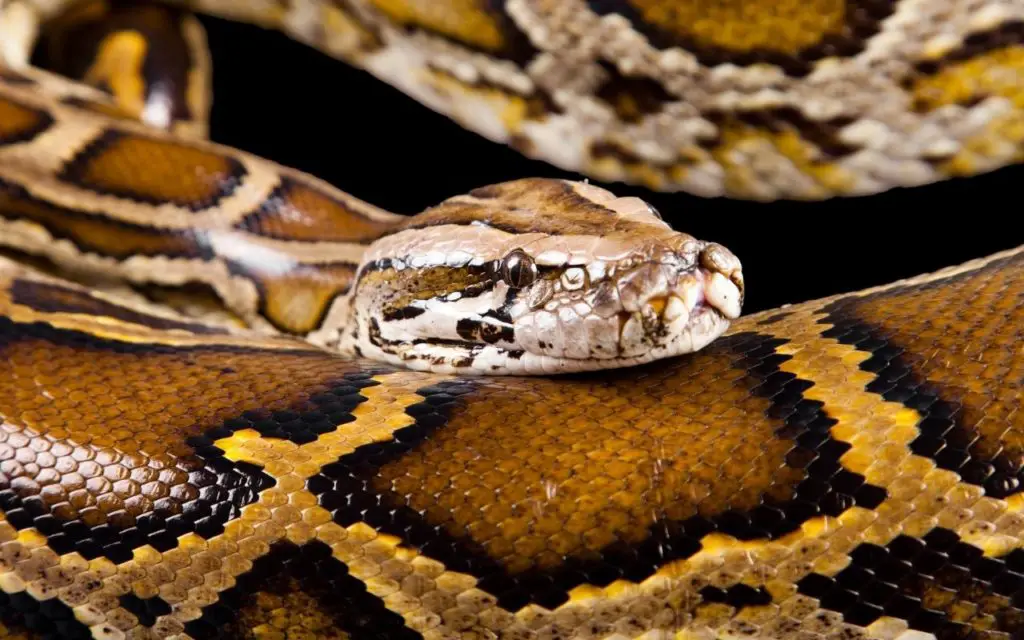
What do pythons look like?
Pythons come in varied lengths, colors, and patterns. Some are tan, grayish black, spotted brown, green, or golden-yellow whereas some may have cream bellies, with brown blotches, thick yellow stripes, etc.
They size from 20 inches to up to 20 feet more or less, and weigh between 500 grams to over 80 kilograms, according to their species and environmental conditions. Most of the largest species are actually quite similar in appearance: brown and blotchy. There some incredibly bright species too, however, such as the Northern Green Tree Python, below.

Where do pythons live in Florida?
Burmese Pythons are found in southern Florida, mostly in and around the Everglades wetland and prairies. The majority of them are situated near Miami-Dade County, and recent surveys suggest that they are advancing closer to Broward and nearby metropolitan areas.
It is also thought that the African Rock Python has become established within the same area. It’s hard to get good information on its population status, though, and most experts agree that likely only occupies a very small range.
Do pythons eat humans?
Pythons do not generally eat humans. They have a hard time swallowing prey with such wide shoulders, and prefer a smaller mammal or bird any day of the week. In general, you will never know if you live near pythons because they are often shy and nocturnal.
Notwithstanding, there have been cases of Reticulated Pythons, Burmese Pythons, Central African Rock Pythons and Southern African Rock Pythons eating or killing people. This usually happens when humans are competing with large snakes for food, by hunting in the same habitat as them, or when someone keeps a large Python in neglectful conditions.
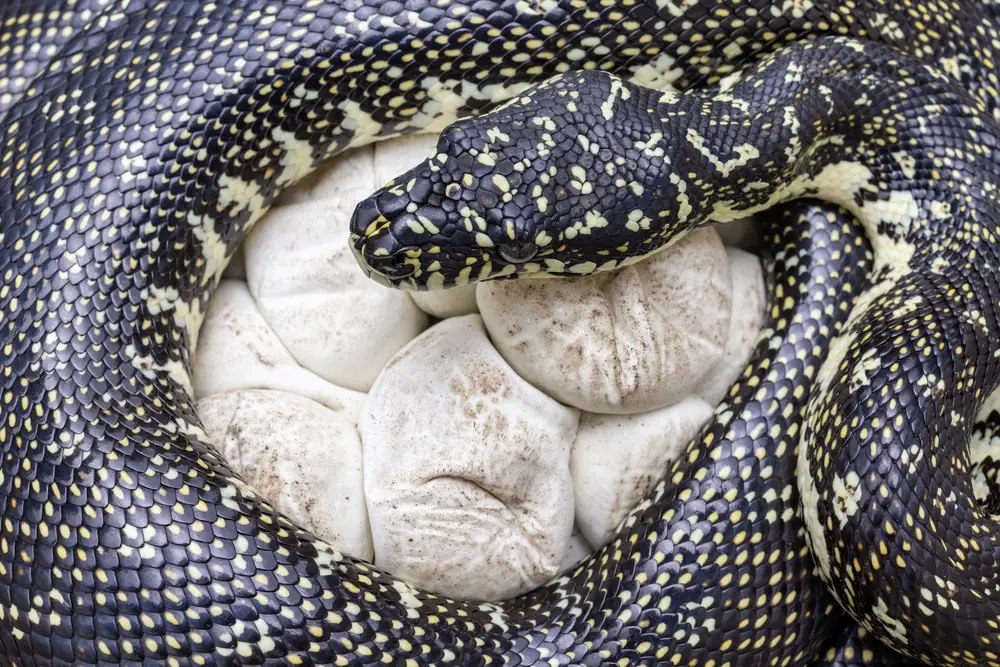
What are 3 facts about pythons?
Here are three interesting facts about pythons –
- Pythons are poikilotherms, which means that they are dependent on external sources of heat for the maintenance of their body temperature.
- In some regions, pythons enter a condition known as brumation, where they decrease their rate of metabolism during cool weather.
- Contrary to popular belief, pythons are not aggressive. They are solitary animals, which generally attack only when provoked or under defensive conditions.
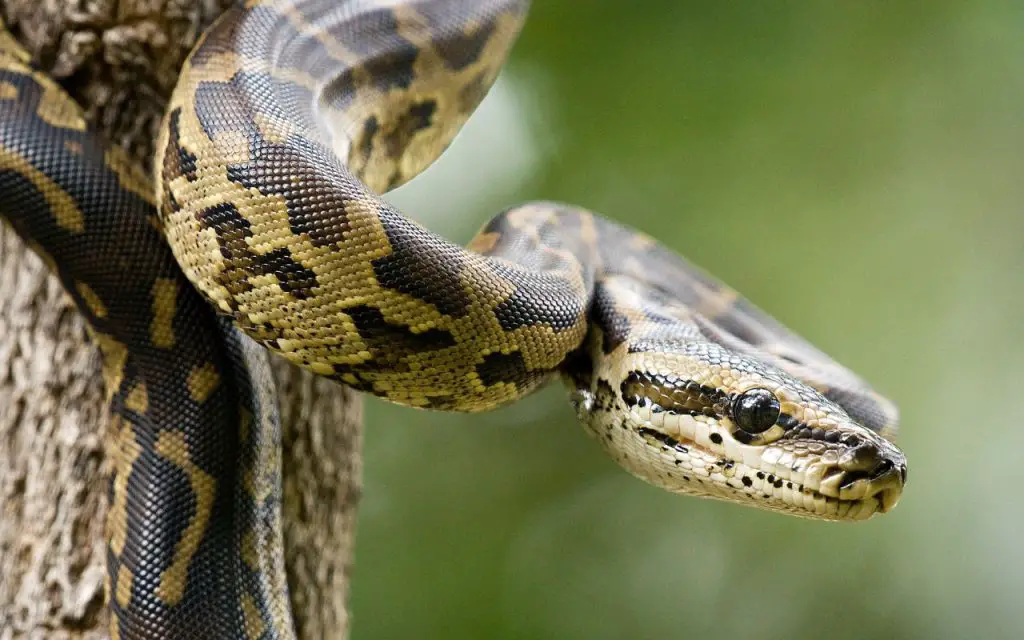
Do pythons bite?
Yes, most pythons are capable and do bite their prey. A python bite can scratch, penetrate the skin and also seriously bruise the individual being bitten. Some can also cause real damage to the internal blood vessels at times.
Again, these snakes are non-venomous, and their bite is not as dangerous as the bite of a venomous species. It is nonetheless recommended to consult a doctor as soon as possible to avoid further complications such as an infection.
Some pythons such as Ball pythons are gentle and do not bite. They make excellent pets when kept under the correct husbandry conditions.
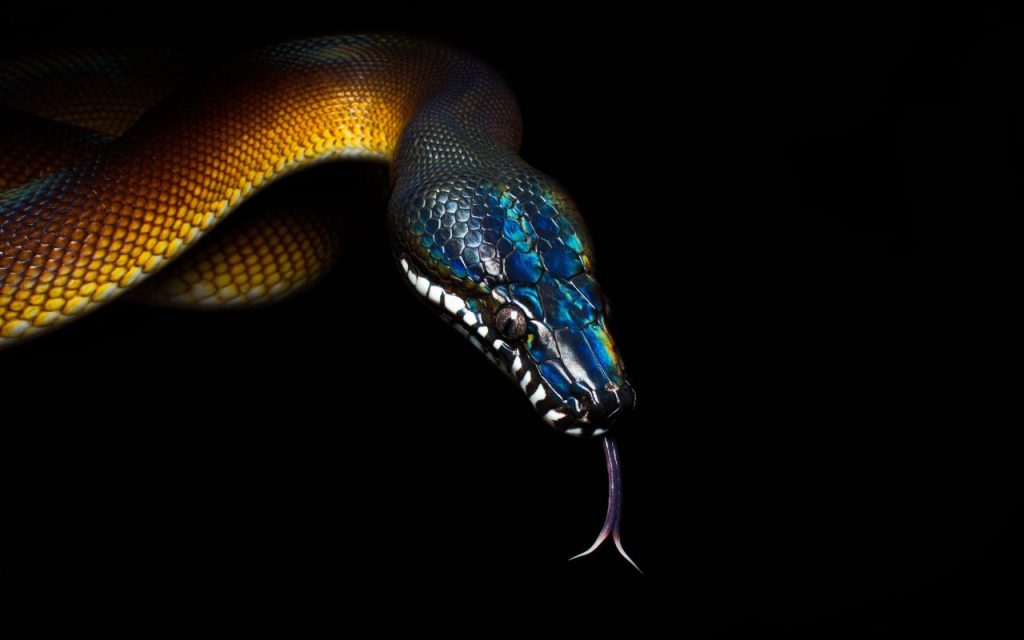
Does a python bite hurt?
It depends upon the size, weight, and species of python. Small species like Ball Pythons can only give you a light scratch at best. Big ones like the Reticulated Python will hurt a lot if they bite you, though.
In general, Pythons give two types of bite:
- A defensive bite: this is to warn you to back off. It’s like a light scratch, and doesn’t hurt much at all.
- A feeding bite: this is when the snake mistakes your hand for food. In this case it will hang on, and with big snakes it really, really hurts.
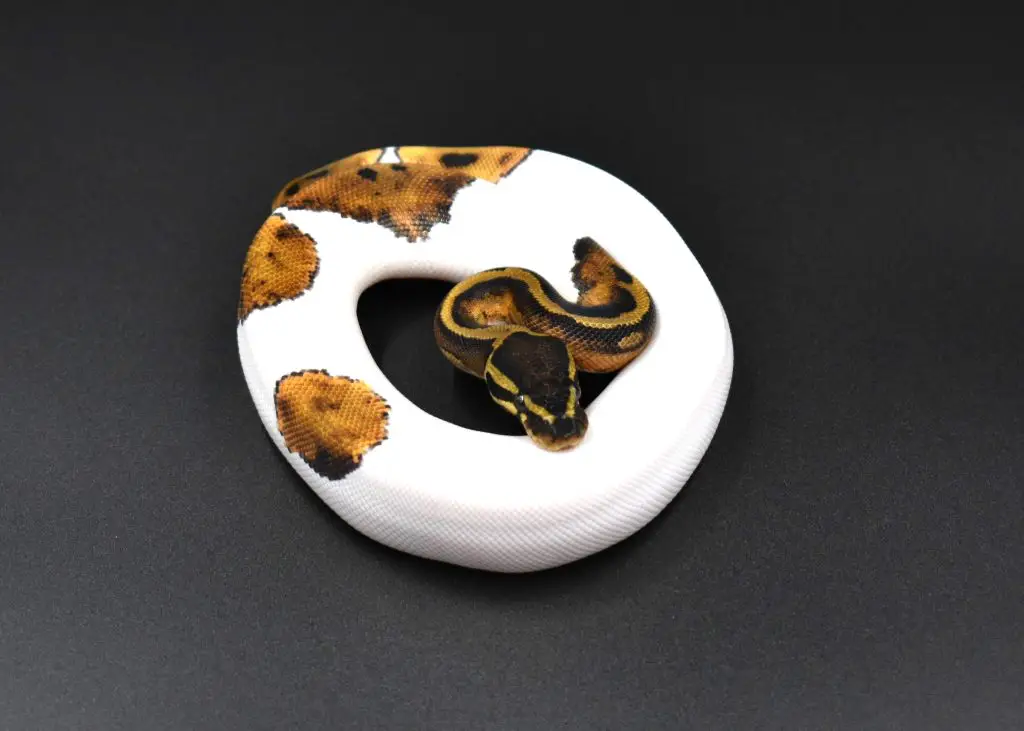
What eats pythons?
Various birds (such as eagles, and vultures), hyenas, lions, leopards, tigers, crocodiles and monitor lizards, are natural predators of pythons. One species of snake, the King Cobra, is even a snake-eating specialist and regularly eats small pythons.
Interestingly, videos have recently emerged of Indigo Snakes and Alligators eating young Burmese Pythons in Florida. It would seem that Pythons only reach the top of the food chain when fully-grown.
How do pythons kill their prey?
All species of Python are constrictors that latch onto their prey, then wrap around and squeeze until it stops breathing. Squeezing the victim’s body cuts off the blood supply to the neural as well as the cardiovascular systems. This results in quick death of the prey.
According to reports from some West African snake catchers, Ball Pythons also press rodents against the walls of their burrow to squash them to death. This allows them to kill several rodents at a time, even if they’re already constricting one.

Are pythons dangerous?
Pythons, like most reptiles, choose to attack only under two circumstances – when cornered, or when very hungry. Overall, they don’t like a fight, and prefer to flee humans whenever possible. Even when they catch their prey, they prefer to catch it by surprise.
So in general no, pythons are not dangerous. Notwithstanding, they are large, powerful animals that should be respected and left in peace when encountered.

FAQs related to where pythons live
What country do pythons live in?
Pythons live in over two dozen countries accross Africa, Asia, and Australasia. The largest species live in Africa and Southeast Asia. The country with the highest overall number of Python species is Australia, which has around 15 discovered species so far.
Where are pythons most common?
Pythons are most common in undisturbed and wild areas of Australia, Africa, and Asia. Two countries where Pythons are commonly encountered by humans are Thailand and Australia. In both countries, Pythons accidentally enter urban areas near to their natural habitat several times a year.
Why is Florida full of pythons?
Florida is not full of Burmese Pythons. In fact, they’re only established and breeding in the southern tip of Florida, where they have become invasive. In the Everglades they have become particularly numerous because the climate is subtropical and there are no native Python species to compete with. Only time will tell how far north they spread, but I suspect it will be less far than many estimates suggest.

